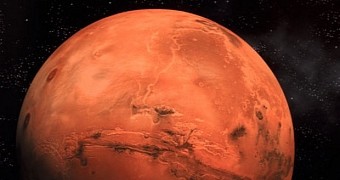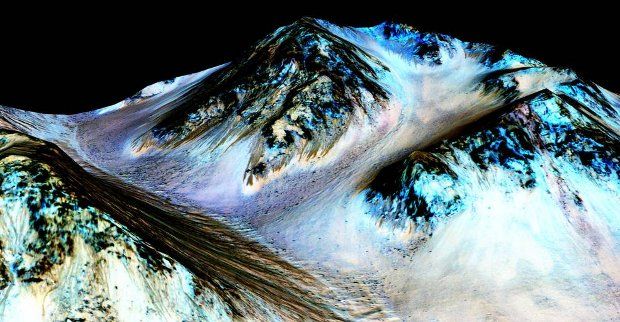Named after the Roman god of war, Mars is the fourth planet from the Sun. For decades, it was believed to be a dry and barren world. But not anymore.
Earlier today, during a conference at the NASA Headquarters in Washington, scientists made a rather puzzling announcement: liquid water flows on the surface of the Red Planet even in this day and age.
The discovery changes pretty much everything we thought we knew about Mars. As it turns out, there is more to this planet than meets the eye. A proper water cycle, that is.
“When most people talk about water on Mars, they're usually talking about ancient water or frozen water. Now we know there’s more to the story,” researcher Lujendra Ojha of the Georgia Institute of Technology in Atlanta said in a statement.
“It took multiple spacecraft over several years to solve this mystery, and now we know there is liquid water on the surface of this cold, desert planet,” added Michael Meyer, lead scientist for the Mars Exploration Program at NASA Headquarters.
Finding evidence of liquid water on Mars
NASA's Mars Reconnaissance Orbiter was launched in August 2005 and reached the Red Planet in March 2006. Once in Mars' orbit, it got to work studying its surface, its atmosphere, and shifts in weather conditions.
Fast forward a few years, and in 2010, researcher Lujendra Ojha, then an undergraduate student at the University of Arizona, noticed some rather puzzling features in a series of images beamed back by the Mars Reconnaissance Orbiter.
Such peculiar features, known as recurring slope lineae (RSL) and described by astronomers as darkish streaks that retreat or grow bigger over time, have since been documented at dozens of sites across Mars' surface.
Scientists say these recurring slope lineae on Mars form during warm seasons in regions where temperatures are higher than minus 10 degrees Fahrenheit (minus 23 degrees Celsius) and then vanish during cold seasons.
The animation below simulates a flyby of such dark streaks shown advancing down the slopes of the Red Planet's Hale Crater. The streaks in this animated video are about the length of a football field, NASA explains.
Judging by their behavior, scientists think these so-called recurring slope lineae documented by NASA's Mars Reconnaissance Orbiter on the surface of the Red Planet are proof of liquid water flowing on the orb's surface.
As noted, the streaks appear and then flow down steep Martian slopes during warm seasons. Then, the Mars Reconnaissance Orbiter has detected the presence of hydrated minerals on the very slopes on which these lineae appear.
Hence, it makes sense to assume that the streaks themselves are the result of liquid water working its way down slopes on the Red Planet, albeit only every once in a while and most likely in the form of brine, researchers say.
“We found the hydrated salts only when the seasonal features were widest, which suggests that either the dark streaks themselves or a process that forms them is the source of the hydration,” explained scientist Lujendra Ojha.
“In either case, the detection of hydrated salts on these slopes means that water plays a vital role in the formation of these streaks,” the specialist went on to comment on this discovery.
The minerals associated with the Red Planet's recurring slope lineae appear to be perchlorates. Thus, scientists have identified the chemical signatures of magnesium perchlorate, sodium perchlorate, and magnesium chlorate.
OK, so what does this discovery mean?
As pointed out by specialist Lujendra Ojha and fellow researchers, the general view used to be that it was only during its younger years that Mars might have been home to liquid water. Now we know that this is not the case.
The Red Planet is a far more entertaining place than we thought it to be, one that could even prove life-friendly. After all, liquid water is a prerequisite for lifeforms to emerge and evolve.
Then, if we're really planning to send astronauts to Mars in the near future, it's important to know which regions would be the best place to set up camp in, NASA scientists explain.
As researcher Michael Meyer put it, “The more we study Mars, the more we learn how life could be supported and where there are resources to support life in the future.”
"Under certain circumstances, liquid water has been found on Mars" - Jim Green, NASA Planetary Science Director https://t.co/MvErxberG3
— NASA (@NASA) September 28, 2015
"These are dark streaks that form in late spring, grow through the summer & disappear in the fall" #MarsAnnouncement https://t.co/Q9wcpY28dn
— NASA (@NASA) September 28, 2015
Miss today's #MarsAnnouncement? Here's the highlights on evidence that liquid water flows on present-day Mars: https://t.co/sFKSJo7VqD
— NASA (@NASA) September 28, 2015

 14 DAY TRIAL //
14 DAY TRIAL // 


